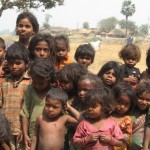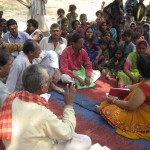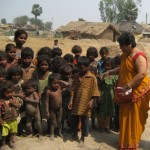In the year 2007, APCL conducted a programme on “Broad streaming of underprivileged education in Jamsaut Panchayat”. The project tried to identify the special learning needs including content and transaction methodology of the underprivileged sections of society and worked on underprivileged children mainly belonging to Musahar community to formulate proper strategy for ensuring right to education in respect of underprivileged community.


A survey of underprivileged children showed that the children of underprivileged children did not get proper environment at home conducive to motivate them to go for learning. So we have to work at both school and community level. Creative Learning Centres were established and run in the hamlets of underprivileged sections to complement and supplement the learning at school. This has proved very successful for first generation learners and other vulnerable groups. Workshops of stakeholders, VEC members and Panchayat workers were also conducted. Wall writing related to new interactive pictures and social issues related to mathematics, language, social studies were done on the walls of schools. The pictures were so designed that they enhance the self esteem of underprivileged section of society.
Songs were also composed highlighting the contribution of underprivileged society particularly musahars. It has been helpful in raising the morale of the community. It was also found that these children enjoyed playing with soil and is very good at terracotta works. So terracotta works was used for enthusing and initiating learning. A BAL Mela was also organized to display the talents of the children. This was found to be en extremely useful tool for motivating underprivileged children as it was a unique occasion for finding their creative works displayed for public view. Saturday events were also organized for the children where all children of Creative Learning centres gathered at one place. These gatherings were used for common functions and power point display of local scenes and activities for discussions. This has been found to be extremely useful for generating awareness about local issues.
However, it was found that we have to simultaneously work on school, VEC, panchayat and community to make schools really functional. Without achieving this constitutional right of free and compulsory education would remain a distant dream. We have enrolled children but with high drop out and absenteeism, there is a serious question of virtual schooling. One of the major tasks is to see how these schools can be made functional, where schools can perform the expected role with effectiveness.
In 2008 the organization worked on making schools functional in Jamsaut Panchyat. The Organisation has developed a model of community intervention through Shabari Ashrams into making schools functional. It has worked in close coordination with school, and community to ensure proper functioning of the school system. It worked closely with Panchayati Raj Bodies to empower them to effectively monitor education system. For this purpose it organized First Panchayat Siksha Sammelan in Jamsaut Panchayat, where all schools made a presentation of their school activity before the community. This was an extremely nice tool to make school system accountable to community.
It further strengthened Shabari Ashrams which worked with the community to empower and prepare children to effective participate in the activities of the school system. It also worked with community to prepare them to effectively participate in the activities of the school.
The organisation has been working in Darbhanga in various projects earlier. Darbhanga district is an extremely backward district of Bihar. It is always visited by floods which has retarded the growth of the area. Particularly the Biraul Block is extremely vulnerable. It has a very high musahar population (Total 9056, Male 4560 and Female 4406) of Musahar community, which has literacy rate less than 9% in the state.
It is surprising that this community belonging to has remained totally excluded from the learning scenario. Similarly, minority particularly Muslims are also extremely vulnerable and have remained alienated from the school education. Our studies have shown that Muslim children also show similar behaviour as Dalit and EBCs (Extremely backward castes). Muslims have a problem related to language also. Formal school needs to take care of this concern. State govt. has provided Urdu teachers in some schools but they only limit themselves to teaching of urdu as a language whereas what children require is proper integration of total language environment of the child into the system.
In the present project it is intended to work for ensuring right to education to underprivileged particularly SC and Muslims in Biraul Block of Darbhanga district. We shall start work from Patania Panchayat which would be extended to other areas subsequently.
Achievements
- Conducted transact walk in 12 wards of Jamsaut Panchayat
- Developed survey schedules, discussion formats and guide book for survey and conducted survey of 11142 persons in 2005 families of the Panchayat to identify 187 non admitted and school drop outs from the villages in the tolas of Scheduled caste and backward community. 53 males and 54 females were identified from Musahar Community. The key problems of non school going children were studied in detail a survey report was prepared.
- Conducted drive for admission into Government schools and got all children admitted to schools. Lobbied with Education Department for solving problems of admission such as direct non admission into class V. The issue was solved after getting intervention from local education Department officials.
- Developed songs, games and activities based on local language and culture for Creative Learning Centres by organizing material development workshop
- Selected 7 Volunteer teachers from the community
- Conducted 3 days training Programme of volunteer teachers
- Established and run 7 Creative Learning Centres in Tolas of weaker sections. Volunteer teachers also supported government schools in absence of teachers.
- Profile of 187 children was prepared to understand their critical issues.
- Ran a composite meeting of Creative Learning Centre on each Saturday to enthuse a sense of competition and also to solve common problems.
- Diaries were maintained by all volunteer teachers about the activities of school and interaction with community members and school teachers.
- Conducted a stakeholders meeting of the education system of Panchayat. The finding of survey was discussed with them.
- Conducted 18 community meetings in different tolas of weaker section of Panchayat
- A Bal mela of children of Creative Learning Centres was organised to display the creative products of terracota, leaves and paintings as well as songs, dances and drama
- Conducted a workshop of members of Vidyalaya Education Committees to make them aware of issues of right to education
- Conducted a workshop of Panchayati Raj functionaries to make them aware of issues of right to education
- Developed a set of interactive pictures and messages for wall writing for improving learning environment of schools and got it on written on the walls of 6 government schools
- Organised Panchayat Siksha Sammelan in Jamsaut Panchayat
- Organised a Bal Mela centrally of all underprivileged children and then exhibitions were replicated in different schools of Jamsaut Panchayats
- Organised a workshop on “Gunatmak Siksha Hetu Vidyalayon Ka Sahi Karyashilan” for functionalizing schools at ANSinha Institute, Patna in collaboration with Samajik Shodh Evam Vikas Sansthan, Mehasi
Biraul Block
The programme is being conducted in Biraul Block in Patania and Ramnagar Panchayat in Darbhanga district. The block is situated in south western part of Darbhanga district and is located in extremely interior region. It is about 50 kms away from district headquarter and 10 kms away from subdivision and block headquarter. As it is frequently visited by floods, the area has poor network of roads and has extremely poor connectivity. As such it has lagged behind in the developmental process.
There are 40109 households in Biraul block. The total population of the block is 233029 (Males 121966, Females 111063). It is predominantly SC inhabited area with 41767 populations. (Male 21685, Female 20082). The block has very poor literacy rate at 38.79% (Male literacy rate 58.03% and Female literacy rate 23.64%).
Musahars belong to scheduled caste but are at lowest rung of educational development. As per 2001 census they have a literacy rate in Bihar of 9 percent with male literacy rate of 13.7 per cent and female literacy rate 3.9 percent. They are mainly agricultural workers. In Biraul Block the population of mushars is very high at 9056 (Male 4560 and Female 4406).
There are 2357 households in Patania. It has 5 primary and 1 middle school. There are 3 non-governmental schools. This way, there are 9 schools in the panchayat. There are 14 wards in the Panchayat. Obviously most of the wards are without a school. They have been able to enhance the admission of children. However, the drop out rate continues to be alarming. On the achievement front also the situation is totally grim.
There are 12852 persons (Males 6742, Females 6110) in the panchayat. There are 3706 persons of SC community of which 1970 are males and 1736 females.
The literacy rate in different villages of the Panchayats is as follows:
| NAME | P_LIT_Rate | M_LIT_Rate | F_LIT_Rate |
| Rampur |
12.74% |
23.64% |
3.64% |
| Lalpur |
26.38% |
42.95% |
10.58% |
| Patania |
44.27% |
64.97% |
28.49% |
| Sudaka |
9.90% |
18.52% |
2.96% |
| Narayanpur |
41.04% |
57.54% |
29.28% |
| Bhaini |
30.30% |
47.70% |
17.09% |
| Total |
35.54% |
53.53% |
21.77% |
It would be clearly seen that female literacy rate of the Panchayat is as low as 21.77%. The female literacy rate in certain pockets such as Rampur and Sudaka, which is inhabitated by Musahars and other dalit communities is as low as 2-3%. The female literacy rate in Lalpur, which is inhabitated by Muslims and dalits is 10.58%.
Obviously the literacy scenario is extremely hopeless. This results in large number of first generation learners. Therefore, children are not encouraged by parents to go to school. In fact, they are often engaged in household chores. It would also be desirable to work for the orientation and empowerment of women.
We have to make special efforts to ensure that children remain in schools and achieve desired result. It is proposed to start from Patania Panchayat and later extend to entire block.
Objectives
- To develop appropriate learning environment for the children of deprived communities so that they can avail the learning facilities available in the Panchyat
- To make schools of Patania Panchayat functional (A functional school means a school which has proper physical and learning environment, Children are motivated to come to school and there is no social, economic or cultural barrier in their participation of school activities, where studies and evaluation are conducted timely and properly, where there is proper coordination between children teachers and parents, where teachers, parents and communities are properly involved in the management of the school and where there is no discrimination on the ground of caste, sex, religion or race.)
- To advocate with Government for making schools functional
Strategies
- To conduct education survey and find out children not going to school, enrolled but not going to school/dropped out and to find out specific reasons thereof in the age group of 6-14 years
- To advocate for appropriate environment in the schools as per needs of the underprivileged children (SCs, Muslims and EBCs)
- To functionalise governmental schools in the area under project
- To build capacity for VEC, PRIs, teachers, volunteer teachers and parents
- To develop community based interventions in the form of Shabari Ashrams(SAs) to complement supplement the efforts of schools
- To design relevant materials for teaching, learning, monitoring and evaluation particularly for SAs
- To design activities and teaching learning materials for CLCs to supplement the special needs of the target group
- To keep lively contact with the parents and other community members to maintain retention of school children and to ensure proper achievement
- Create systems for child tracking
- Mapping of the concerned officials in the education department and developing linkages with them. Ensure information flow from the officials to community members.
- Develop leadership in the community so that they are able to address the problems independently.
- Ensure that VEC members participate in gram sabha meetings to highlight issues related to education
- To prepare indicators for gradation of schools on the points of functional school and circulate report cards on schools on periodical basis and share with community and Panchayat and to organize Panchayat Siksha Sammelan for this purpose
- Improvement of school environment by wall writing and other methods so that the school becomes attractive for learners.
- Organizing Bal Melas and sports meet in schools or group of schools
- To conduct advocacy for appropriate environment in the schools as per needs of the underprivileged children.
- To keep live contact with the parents and other community members to maintain retention of school children and to ensure proper achievement
